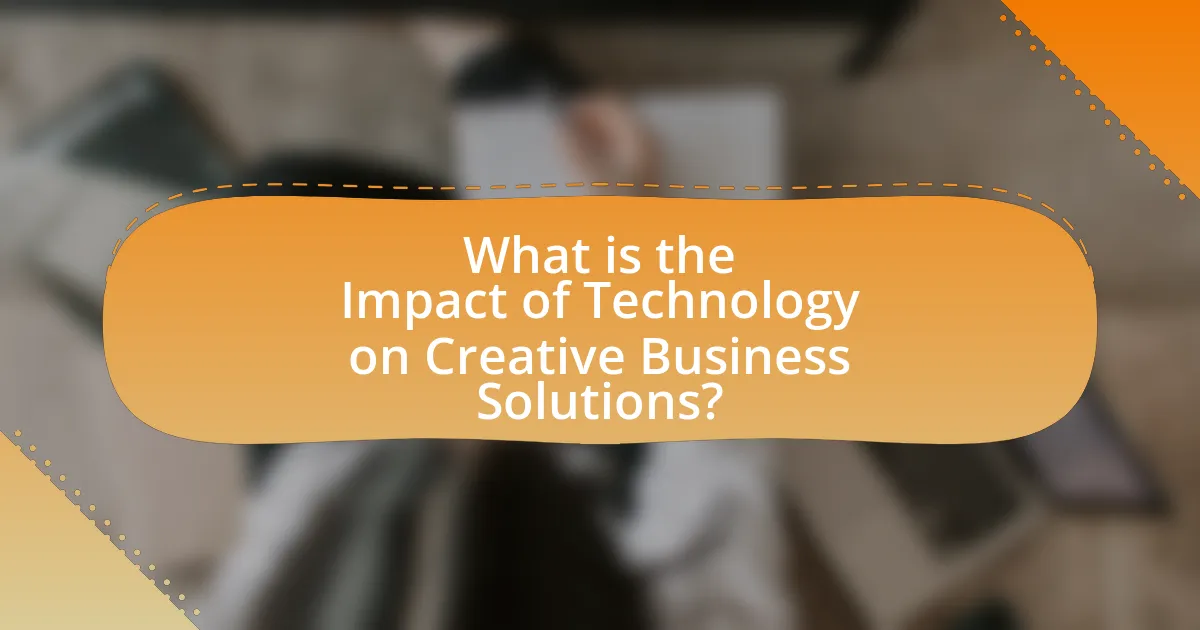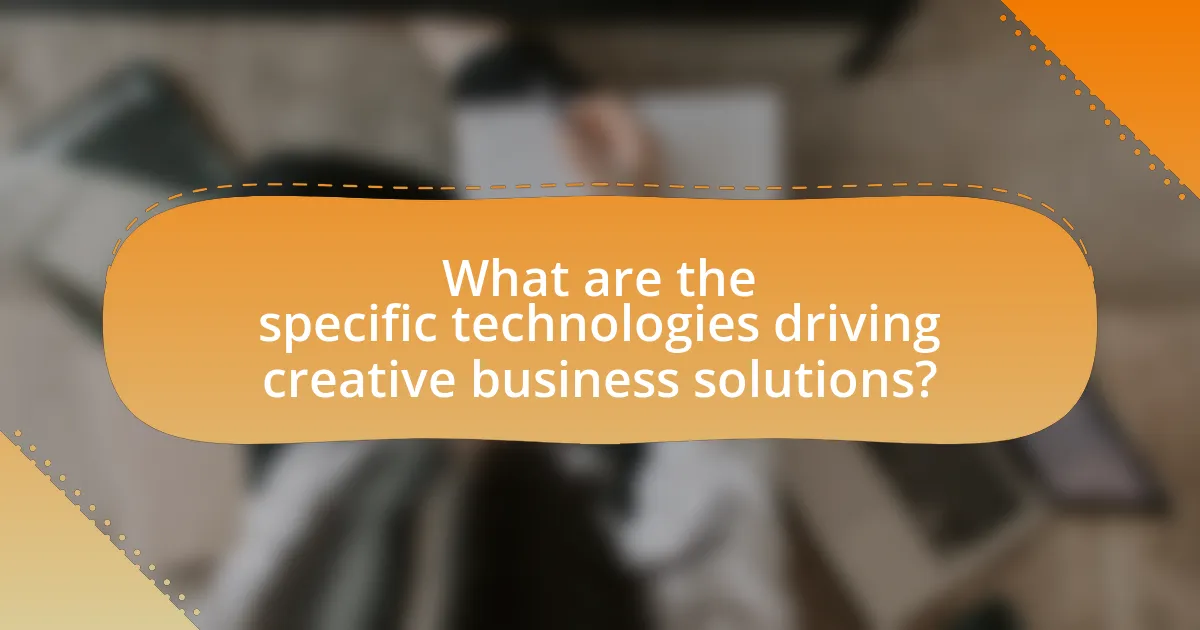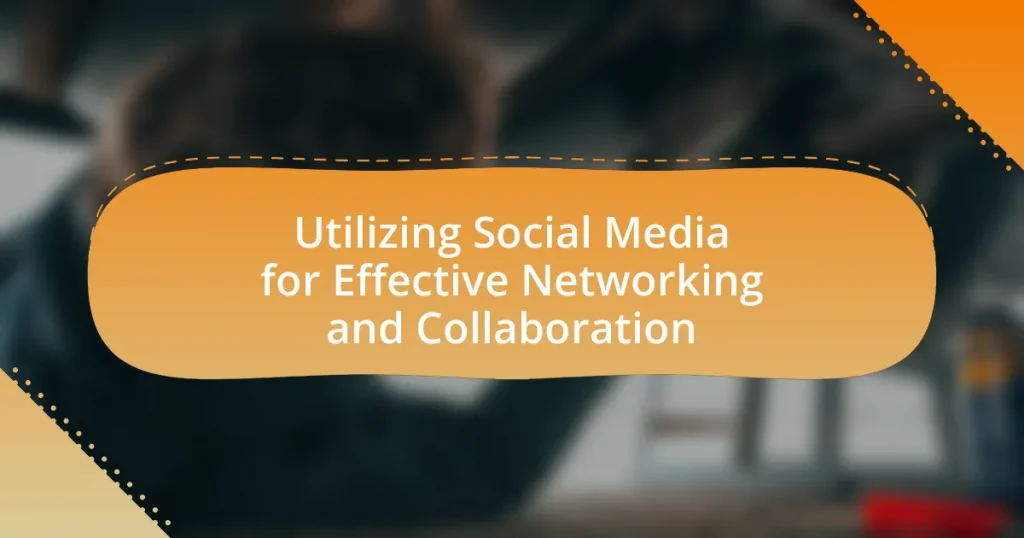The article examines the impact of technology on creative business solutions, highlighting how advancements such as artificial intelligence, cloud computing, and data analytics enhance innovation, efficiency, and collaboration. It discusses the transformation of creative business practices through digital tools, the importance of understanding technological impacts for competitive advantage, and the risks associated with failing to adapt. Additionally, the article outlines the challenges businesses face in integrating new technologies, strategies to overcome resistance to change, and best practices for successful technology adoption, ultimately emphasizing the role of technology in driving growth and creativity in the business landscape.

What is the Impact of Technology on Creative Business Solutions?
Technology significantly enhances creative business solutions by enabling innovation, improving efficiency, and facilitating collaboration. For instance, tools like artificial intelligence and machine learning allow businesses to analyze data rapidly, leading to more informed decision-making and the development of unique products or services. According to a report by McKinsey, companies that leverage advanced technologies can increase their productivity by up to 40%. Furthermore, cloud computing platforms foster collaboration among teams, regardless of geographical barriers, which accelerates the creative process and allows for diverse input. This integration of technology not only streamlines operations but also empowers businesses to adapt quickly to market changes, ultimately driving growth and competitiveness.
How has technology transformed creative business practices?
Technology has transformed creative business practices by enabling greater collaboration, enhancing efficiency, and expanding access to tools and resources. Digital platforms facilitate real-time communication and project management among creative teams, allowing for seamless collaboration regardless of geographical location. For instance, cloud-based software like Adobe Creative Cloud allows multiple users to work on design projects simultaneously, significantly speeding up the creative process. Additionally, automation tools streamline repetitive tasks, freeing up time for creative professionals to focus on innovation. According to a report by McKinsey, companies that leverage digital tools can improve productivity by up to 20-25%. This integration of technology not only enhances the quality of creative outputs but also allows businesses to adapt quickly to market changes and consumer demands.
What are the key technological advancements influencing creativity in business?
Key technological advancements influencing creativity in business include artificial intelligence, cloud computing, and collaborative tools. Artificial intelligence enhances creativity by providing data-driven insights and automating repetitive tasks, allowing creative professionals to focus on innovative aspects of their work. Cloud computing facilitates access to resources and tools from anywhere, enabling collaboration among teams regardless of location, which fosters diverse ideas and solutions. Collaborative tools, such as project management software and communication platforms, streamline workflows and enhance teamwork, further driving creative processes. These advancements collectively empower businesses to innovate and adapt in a rapidly changing environment.
How do these advancements enhance problem-solving capabilities?
Advancements in technology enhance problem-solving capabilities by providing tools that facilitate data analysis, improve communication, and enable innovative thinking. For instance, artificial intelligence algorithms can analyze vast datasets to identify patterns and insights that humans may overlook, leading to more informed decision-making. Additionally, collaborative platforms allow teams to communicate in real-time, fostering creativity and accelerating the brainstorming process. Research from McKinsey & Company indicates that organizations leveraging advanced analytics can improve their decision-making speed by 5 to 10 times, demonstrating the tangible benefits of these technological advancements in enhancing problem-solving.
Why is understanding this impact crucial for businesses?
Understanding the impact of technology on creative business solutions is crucial for businesses because it directly influences their ability to innovate and remain competitive. Businesses that grasp this impact can leverage technological advancements to enhance efficiency, improve customer experiences, and drive growth. For instance, a study by McKinsey & Company found that companies that effectively integrate technology into their operations can achieve productivity gains of up to 20-25%. This demonstrates that recognizing and adapting to technological changes is essential for sustaining a competitive edge in the market.
What risks do businesses face by not adapting to technological changes?
Businesses face significant risks by not adapting to technological changes, including loss of competitive advantage, decreased operational efficiency, and reduced customer engagement. Failure to embrace new technologies can lead to outdated processes that hinder productivity; for instance, companies that do not implement automation may find themselves unable to keep pace with competitors who do, resulting in a market share decline. Additionally, businesses that ignore digital transformation risk alienating customers who increasingly expect seamless online experiences; research indicates that 70% of consumers prefer to engage with brands through digital channels. Furthermore, cybersecurity threats escalate for businesses that do not update their systems, as outdated technology is more vulnerable to attacks, potentially leading to data breaches and financial losses.
How can businesses leverage technology for competitive advantage?
Businesses can leverage technology for competitive advantage by adopting advanced data analytics to enhance decision-making and optimize operations. For instance, companies like Amazon utilize big data to analyze customer behavior, enabling personalized marketing strategies that increase sales. Additionally, automation technologies streamline processes, reduce costs, and improve efficiency, as seen in manufacturing firms that implement robotics to enhance production speed and accuracy. Furthermore, cloud computing allows businesses to scale resources flexibly, facilitating innovation and collaboration across teams, which is critical in rapidly changing markets. These technological strategies collectively empower businesses to respond swiftly to market demands, outperform competitors, and drive growth.

What are the specific technologies driving creative business solutions?
Artificial Intelligence (AI), cloud computing, and data analytics are specific technologies driving creative business solutions. AI enhances decision-making and automates processes, enabling businesses to innovate rapidly. Cloud computing provides scalable resources and facilitates collaboration, allowing teams to work efficiently from anywhere. Data analytics empowers organizations to derive insights from large datasets, informing strategies and improving customer experiences. For instance, a McKinsey report highlights that companies leveraging AI can increase their profitability by up to 38% by 2035, demonstrating the tangible impact of these technologies on business creativity and effectiveness.
How do digital tools facilitate innovation in business?
Digital tools facilitate innovation in business by enabling streamlined processes, enhanced collaboration, and data-driven decision-making. For instance, cloud computing allows teams to access and share information in real-time, fostering creativity and reducing time-to-market for new products. According to a report by McKinsey, companies that leverage digital tools can increase their innovation productivity by up to 30%. Additionally, analytics tools provide insights into customer behavior, allowing businesses to tailor their offerings and innovate based on actual market needs. This data-centric approach not only drives efficiency but also enhances the ability to adapt to changing consumer demands, ultimately leading to sustained competitive advantage.
What role do collaboration platforms play in creative processes?
Collaboration platforms facilitate communication and idea-sharing among team members, enhancing the creative process. These platforms enable real-time collaboration, allowing individuals to contribute their unique perspectives and skills, which can lead to more innovative solutions. For instance, a study by the Harvard Business Review found that teams using collaboration tools are 20% more productive and generate 30% more ideas than those that do not. This increased productivity and idea generation directly supports the creative process by fostering an environment where diverse thoughts can converge and evolve into actionable concepts.
How does data analytics contribute to informed decision-making?
Data analytics significantly enhances informed decision-making by providing actionable insights derived from data patterns and trends. Organizations utilize data analytics to analyze historical data, identify key performance indicators, and forecast future outcomes, which enables leaders to make evidence-based decisions. For instance, a study by McKinsey & Company found that companies leveraging data-driven decision-making are 23 times more likely to acquire customers, 6 times more likely to retain customers, and 19 times more likely to be profitable. This demonstrates that data analytics not only informs strategic choices but also drives competitive advantage in the marketplace.
What emerging technologies are shaping the future of creative business solutions?
Emerging technologies shaping the future of creative business solutions include artificial intelligence (AI), blockchain, augmented reality (AR), and the Internet of Things (IoT). AI enhances creativity by automating tasks, providing insights through data analysis, and enabling personalized customer experiences. For instance, a McKinsey report indicates that AI can increase productivity by up to 40% in various sectors. Blockchain offers secure and transparent transactions, fostering trust in creative collaborations and intellectual property management. AR transforms customer engagement by providing immersive experiences, as seen in retail applications that allow virtual try-ons. IoT connects devices and gathers data, enabling businesses to optimize operations and enhance product offerings, with a projected economic impact of $4-11 trillion by 2025 according to McKinsey. These technologies collectively drive innovation and efficiency in creative business solutions.
How is artificial intelligence influencing creativity in business?
Artificial intelligence is significantly influencing creativity in business by automating routine tasks and providing data-driven insights that enhance creative processes. For instance, AI tools like generative design software allow designers to explore a multitude of design options quickly, leading to innovative solutions that might not have been considered otherwise. Additionally, AI-driven analytics can identify emerging trends and consumer preferences, enabling businesses to tailor their creative strategies effectively. According to a report by McKinsey, companies that integrate AI into their creative processes can increase productivity by up to 40%, demonstrating the tangible benefits of AI in fostering creativity.
What impact does virtual reality have on customer engagement?
Virtual reality significantly enhances customer engagement by providing immersive experiences that foster deeper emotional connections with brands. Studies indicate that 70% of consumers report a higher emotional connection to brands that utilize virtual reality, as it allows for interactive and personalized experiences that traditional media cannot offer. For instance, companies like IKEA use virtual reality to enable customers to visualize furniture in their own homes, leading to increased purchase intent and customer satisfaction. This immersive technology not only captures attention but also encourages longer interaction times, ultimately driving brand loyalty and sales.

What are the challenges and considerations in implementing technology for creative solutions?
Implementing technology for creative solutions presents challenges such as integration complexity, cost management, and user adaptability. Integration complexity arises when new technologies must work seamlessly with existing systems, which can lead to operational disruptions if not managed properly. Cost management is critical, as the initial investment in technology can be substantial, and ongoing maintenance costs can strain budgets. User adaptability is another significant consideration; employees may resist new technologies due to a lack of training or fear of change, which can hinder the successful adoption of innovative solutions. According to a report by McKinsey & Company, 70% of digital transformation initiatives fail due to these challenges, highlighting the importance of addressing them effectively.
What barriers do businesses face when integrating new technologies?
Businesses face several barriers when integrating new technologies, including high costs, resistance to change, and lack of skilled personnel. High costs can deter investment in new technologies, as businesses may struggle to allocate sufficient budget for implementation and maintenance. Resistance to change often arises from employees who are accustomed to existing processes and may fear job displacement or the learning curve associated with new systems. Additionally, a lack of skilled personnel can hinder the effective adoption of new technologies, as businesses may not have access to individuals with the necessary expertise to manage and utilize these innovations effectively. According to a report by McKinsey, 70% of digital transformation initiatives fail due to these types of barriers, highlighting the significant challenges businesses encounter in this area.
How can companies overcome resistance to technological change?
Companies can overcome resistance to technological change by fostering a culture of open communication and involving employees in the change process. Engaging employees through training programs and feedback mechanisms helps them understand the benefits of new technologies, reducing fear and uncertainty. Research indicates that organizations that prioritize employee involvement in decision-making experience a 70% higher success rate in implementing technological changes. Additionally, providing clear, consistent messaging about the advantages of technology can further alleviate concerns and encourage acceptance.
What are the implications of cybersecurity on creative business solutions?
Cybersecurity significantly impacts creative business solutions by ensuring the protection of intellectual property and sensitive data, which are vital for innovation. A secure environment fosters trust among clients and partners, enabling businesses to explore and implement creative strategies without the fear of data breaches. According to a report by Cybersecurity Ventures, global cybercrime costs are projected to reach $10.5 trillion annually by 2025, highlighting the necessity for robust cybersecurity measures. This financial risk underscores the importance of integrating cybersecurity into the creative process, as businesses that prioritize security can maintain competitive advantages and drive sustainable growth.
How can businesses measure the effectiveness of technology in their creative processes?
Businesses can measure the effectiveness of technology in their creative processes by evaluating key performance indicators (KPIs) such as productivity, quality of output, and time efficiency. For instance, tracking the number of projects completed within a specific timeframe can indicate how technology enhances workflow. Additionally, assessing the quality of creative outputs through client feedback or market performance metrics can provide insights into the impact of technology on creativity. A study by McKinsey & Company found that companies leveraging advanced technology in creative processes saw a 20-30% increase in productivity, demonstrating a clear correlation between technology use and improved creative outcomes.
What metrics should be used to evaluate success?
To evaluate success in the context of technology’s impact on creative business solutions, key metrics include return on investment (ROI), customer satisfaction scores, and project completion rates. ROI measures the financial return generated from technology investments, providing a clear indication of profitability. Customer satisfaction scores, often gathered through surveys, reflect how well the technology meets user needs and enhances their experience. Project completion rates indicate the efficiency and effectiveness of technology in delivering solutions on time and within budget. These metrics collectively provide a comprehensive view of success in leveraging technology for creative business outcomes.
How can feedback loops enhance technology-driven creativity?
Feedback loops enhance technology-driven creativity by facilitating continuous improvement and innovation through iterative processes. These loops allow creators to gather insights and reactions from users or stakeholders, which can be analyzed to refine and enhance technological solutions. For instance, in software development, agile methodologies utilize feedback loops to adapt features based on user experience, leading to more user-centric products. Research by the Harvard Business Review indicates that organizations employing feedback loops in their creative processes report higher levels of innovation and adaptability, demonstrating the effectiveness of this approach in fostering creativity within technology-driven environments.
What best practices can businesses adopt for successful technology integration?
Businesses can adopt several best practices for successful technology integration, including thorough planning, stakeholder involvement, and continuous training. Thorough planning ensures that technology aligns with business goals and addresses specific needs, which is supported by a study from McKinsey that found organizations with clear strategies are 2.5 times more likely to achieve successful technology integration. Involving stakeholders throughout the process fosters buy-in and reduces resistance, as highlighted by research from Prosci, which indicates that projects with active stakeholder engagement have a 70% success rate. Continuous training equips employees with the necessary skills to utilize new technologies effectively, leading to improved productivity and satisfaction, as evidenced by a report from the Association for Talent Development, which states that companies investing in employee training see a 24% higher profit margin.
How can training and development support technology adoption?
Training and development facilitate technology adoption by equipping employees with the necessary skills and knowledge to effectively use new technologies. When organizations implement comprehensive training programs, they enhance user confidence and competence, which directly correlates with higher adoption rates. Research indicates that companies with structured training initiatives experience a 70% increase in technology utilization compared to those without such programs. This evidence underscores the critical role of training in bridging the gap between technology introduction and effective usage, ultimately leading to improved productivity and innovation within creative business solutions.
What strategies can foster a culture of innovation within organizations?
To foster a culture of innovation within organizations, leaders should implement strategies that encourage collaboration, experimentation, and continuous learning. Encouraging cross-functional teams to collaborate can lead to diverse perspectives and innovative solutions, as evidenced by companies like Google, which promotes teamwork through initiatives like “20% time,” allowing employees to spend a portion of their workweek on projects of their choice. Additionally, creating a safe environment for experimentation, where failure is viewed as a learning opportunity, can stimulate creativity; for instance, Amazon’s “fail fast” approach empowers teams to test new ideas without fear of repercussions. Finally, investing in ongoing training and development ensures that employees are equipped with the latest skills and knowledge, which is crucial for driving innovation in a rapidly changing technological landscape.



